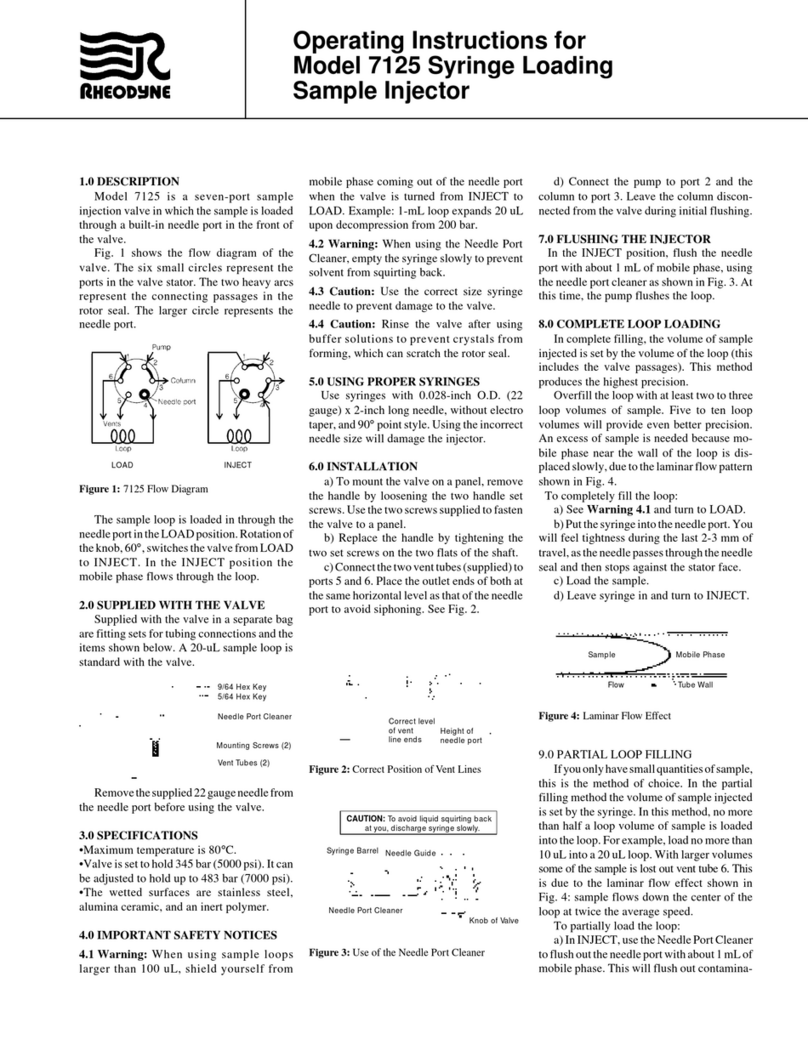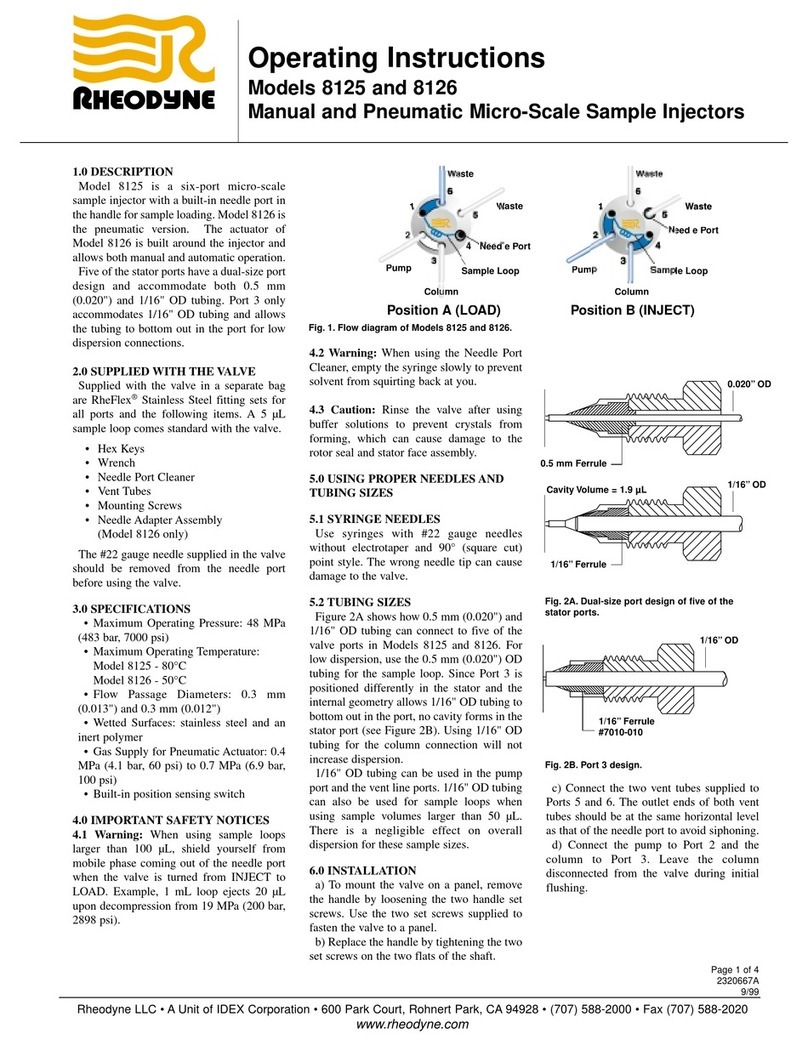flushing.
6.0 OPERATION
6.1 INJECTIONS (MODEL 7010 ONLY)
Before connecting the column to the
injector, flush the injector with mobile phase
in both the LOAD and INJECT positions.
After flushing the injector, turn to LOAD,
and connect the column.
6.1.1 LOADING THE SAMPLE LOOP
Overfill the loop with at least two to five
loop volumes of sample. Six to ten loop
volumes will provide even better precision.
An excess of sample is needed because
mobile phase near the wall of the loop is
displaced slowly due to the laminar flow
effect shown in Figure 2.
To completely fill the loop (see Figure 3):
a) See Warning 4.1 and turn to LOAD.
b) Insert the syringe into the accessory
injection port.
c) Load the sample.
d) Leave the syringe in position and turn to
INJECT.
6.2 SUGGESTED APPLICATIONS FOR
SWITCHING VALVES
Flush the valve with mobile phase before
connecting the valve to system components.
Suggested applications for switching valve
applications are shown in Figures 7, 8, 9, and
10.
7.0 ADJUSTING FOR LEAKAGE OR
HIGHER PRESSURE OPERATION
The three small set screws in the stator (see
Figure 4) have been factory set so that when
the three stator screws are fully tightened, the
spring force between the valve rotor and
stator is sufficient to hold the indicated
pressure. If leakage is to be corrected, or if
operation at a higher pressure is to be done,
proceed as follows: The three set screws
should be loosened about 1/20 turn each (18°
of rotation) and the three stator screws
tightened an equal amount. If this new
setting fails to accomplish leak-free
operation at the desired pressure, repeat the
procedure by an additional 1/20 turn. Avoid
excessive tightening which will only
increase wear of the rotor seal. If it is
necessary to loosen spring tension, either to
lower the operating pressure, or to adjust for
a new rotor seal, which may be thicker than
the one being replaced, reverse the above
procedures. For example, first loosen the
stator screws, then tighten the set screws.
If leakage cannot be stopped by tightening
the valve, or if, as a result of tightening to
stop the leakage, the handle is too hard to
turn, the rotor seal needs replacing. See next
section.
8.0 MAINTENANCE
The only parts that may need eventual
replacement are the rotor seal and isolation
seal. Abrasive particles in the sample can
damage the rotor seal.
Genuine Rheodyne parts are easily replaced
by the following instructions.
8.1 DISASSEMBLY
To disassemble the valve, refer to Figure 4
and proceed as follows:
a) Remove the three stator screws.
b)Remove stator and stator ring from
valve body.
c) Pull the rotor seal off of the pins.
d)Remove the isolation seal.
8.2 REASSEMBLY
8.2.1 TWO-POSITION VALVE REASSEMBLY
To reassemble Models 7010, 7000, 7030,
and 7040, refer to Figures 4 and 6 and
proceed as follows:
a) Mount the new isolation seal onto the
shaft with the open side facing the handle.
b) Be sure that the rotor seal is correctly
oriented as shown in Figure 6 with rotor seal
grooves facing the stator and with the notch
in the metal rim of the rotor seal in line as
shown (the notch also faces the stator).
c) In replacing the stator ring, be sure that
the two stop pins are still in their holes in the
stator ring, then push the stator ring squarely
onto the shaft assembly allowing the stop
pins to enter the mating holes in the body. Be
sure the rotor pin is located between the two
stop pins (Model 7060 does not have a rotor
pin so the rotor can be in any position).
d) Replace the stator by first pushing it
onto the two pins on the stator ring and then
adding the three stator screws. Tighten each
screw a little at a time to keep the stator
surface parallel to the stator ring surface. If
the three set screws in the stator were left
unchanged, tighten the three stator screws a
1/2 turn past fingertight. The three set screws
will ensure that the gap between stator and
stator ring is uniform and in the original
position before disassembly.
e) If the set screws need adjusting because
a new rotor seal was installed or because
leakage has to be stopped, each set screw
should be turned an equal amount to ensure
that after the stator screws are retightened,
the gap between the stator and stator ring is
uniform all around. Refer also to Section 7.0.
8.2.2 MODEL 7060 REASSEMBLY
An arrow has been engraved on the knob
end of the shaft. Orient the rotor seal on the
rotor as shown in Figure 6 relative to this
arrow (with the grooves in the rotor seal
facing the stator).
Follow the steps in Section 8.2.1.
8.3 ATTACHING HANDLE
The knob for the Model 7060 has a single
set screw located opposite the black handle.
The knob should be oriented on the Model
7060 shaft so that the knob pointer points in
the same direction as the arrow on the end
of the shaft. The set screw should be
tightened on the flat of the shaft with the tip
of the set screw centered on the hole in the
shaft. Confirm this centering before final
tightening of the set screw.
The knob for the two-position valves has
two set screws, both at 90° from the black
handle. It is best to tighten only the one set
screw on the flat of the shaft although both
set screws can be tightened. Confirm that
the set screw tip is centered on the hole in
the shaft before tightening (remove one set
screw to observe alignment while tightening
the other).
Fig. 2. Laminar flow effect.























